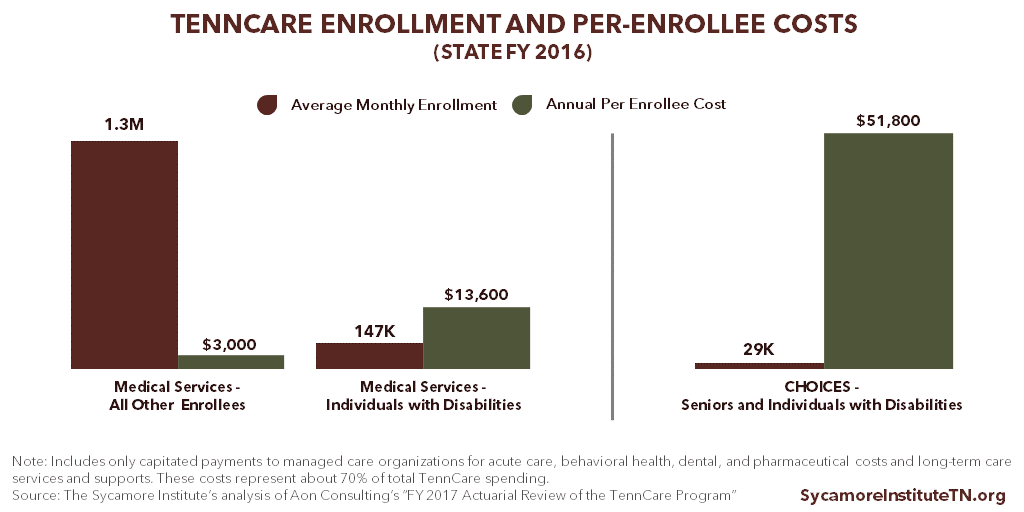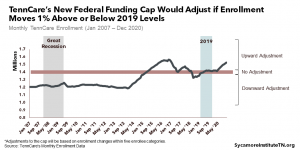
Many Tennesseans require assistance with the tasks and chores of daily life, such as eating, bathing, and taking medications. These long-term services and supports (LTSS) are often expensive and rarely covered by private health insurance. Low-income Tennesseans who are elderly or have a disability may be eligible for LTSS through TennCare, our state’s Medicaid program.
TennCare primarily funds long-term services and supports through three programs:
- The CHOICES program provides LTSS to about 30,000 elderly Tennesseans and Tennesseans with physical disabilities via both home- and community-based services (HCBS) and nursing home care. (1) (2)
- The Tennessee Department of Intellectual and Developmental Disabilities (DIDD) provides home- and community-based services to nearly 8,000 Tennesseans with intellectual and developmental disabilities. Often called the “DIDD waivers,” this program closed to new enrollment in July 2016. (3)
- The new Employment and Community First (ECF) CHOICES program provides home- and community-based LTSS to about 1,700 Tennesseans with intellectual and developmental disabilities. (4)
Under both of the CHOICES programs, private health insurance companies contract with TennCare to coordinate all LTSS services. These insurers are known as managed care organizations or MCOs, and this method of delivery is sometimes referred to as managed LTSS or mLTSS.
Costs of TennCare Long-Term Services and Supports
Individuals who receive long-term services and supports often have complex medical conditions and tend to be some of TennCare’s most expensive enrollees. For example, while about 10% of TennCare enrollees have disabilities, their medical and CHOICES LTSS expenses represent 35% of TennCare’s medical services spending. (5) (1) Medical services (including drug costs) per TennCare enrollee with a disability cost about 4.5 times the average for all other enrollees. CHOICES LTSS per-enrollee costs are about 17 times other enrollees’ medical costs (Figure 1).
Private insurance plans rarely cover long-term services and supports. (6) Nationwide, Medicaid programs are the largest payer for LTSS. (5) Because these services can be so costly, few if any current TennCare enrollees could likely afford to pay for LTSS out of pocket. (6)
Figure 1
TennCare’s Use Of Optional Coverage
TennCare has expanded its coverage of long-term services and supports beyond what federal Medicaid law requires. Tennessee’s use of optional eligibility and benefits reflects a nationwide effort to prevent people from going into nursing homes and to “rebalance” the site of care for the elderly and individuals with disabilities. Optional LTSS coverage offered by TennCare includes:
- Coverage of home- and community-based services. Federal law generally only requires that states cover nursing home care.
- Coverage for seniors and individuals with disabilities who have incomes up to 224% of the federal poverty line (FPL). Federal law only requires coverage for seniors and individuals with disabilities receiving Supplemental Security Income, which has an annual income limit of about 74% of FPL.
- Coverage for individuals who are at-risk for needing a level of care traditionally provided in a nursing home. Federal law only requires coverage for eligible individuals who need a nursing home level of care.
Table 1 provides a detailed comparison of TennCare’s LTSS coverage with what is required and optional under federal law.
We estimate about 22,000 Tennesseans (elderly and/or with disabilities) received optional TennCare-funded home- and community-based LTSS in state FY 2015-2016. This includes all enrollees in the DIDD waivers and ECF CHOICES. It also includes about 42% of CHOICES enrollees who received home- and community-based LTSS. (2)
Of note: Tennessee’s use of optional LTSS eligibility criteria also makes many individuals with disabilities eligible for TennCare coverage of medical services.
Table 1. Federal Requirements Vs. TennCare Coverage for People with Disabilities |
||
|---|---|---|
| What’s Required Under Federal Law? | What’s Optional Under Federal Law? | What’s Covered by TennCare? |
| Medical services must be provided to seniors and individual with disabilities receiving Supplemental Security Income (SSI), which amounts to an annual income of about $8,820 per year (or 74% of the federal poverty line (FPL)) and $2,000 in assets for an individual. | If states use federal flexibilities to extend LTSS to other populations, those populations must also be granted access to medical services. | TennCare covers medical services for seniors and individuals with disabilities receiving SSI and individuals who are eligible for LTSS. |
| LTSS must be provided to seniors and individuals with disabilities receiving SSI who need the level of care traditionally provided in a nursing home. | States have the flexibility to expand LTSS services to other individuals not otherwise eligible using a state-defined “level of care” criteria to determine eligibility (e.g. to identify individuals “at risk” for needing nursing home level of care). | TennCare covers LTSS for seniors and individuals with disabilities – including physical, intellectual, and developmental disabilities – with incomes of up to $24,300 per year (or 224% of FPL), $2,000 in assets, and who need or are at risk for needing nursing home level of care. |
| LTSS services must include nursing home care and/or home health care* only for eligible individuals who need nursing home level of care. | All other LTSS benefits – including HCBS and care in an intermediate care facility for individuals with intellectual disabilities (ICF/IID) – are optional under federal law. | TennCare covers both nursing home care and HCBS for eligible individuals needing or at-risk for needing nursing home level of care. TennCare also covers ICF/IID. |
* “Home health care” is a specific type of service in the category of home- and community-based services.
Source: Kaiser Family Foundation, the Medicaid Payment and Access Commission, and the Tennessee Division of Health Care Finance and Administration (5) (7) (8) (9)
Controlling TennCare LTSS Costs with HCBS and Managed Care
Long-term services and supports are generally far less expensive when delivered as home- and community-based services than in nursing homes. HCBS may also be less disruptive to daily life because enrollees can continue living in their own homes and communities. Over the last decade, Tennessee has worked to control its LTSS costs by:
- Shifting individuals who need nursing home care into home- and community-based services. TennCare spends an average of $60,000 per year on LTSS at nursing homes for an individual needing a nursing home level of care. When the same individual receives services in a home- and community-based setting, the average cost drops to $17,000 per year.
- Covering home- and community-based services for individuals at risk of needing nursing home care. (5) TennCare’s average annual cost to provide HCBS for seniors at risk of needing a nursing home level of care is just $8,000. (10) (5)
Over the last decade, Tennessee has reduced the proportion of LTSS enrollees in nursing home care from almost 97% to about 60% while increasing the proportion receiving HCBS from 3% to 40%. (11)
Additionally, Tennessee has transitioned to using managed care companies to more cost-effectively manage home- and community-based services for individuals with intellectual disabilities. Under the DIDD waivers, the state directly manages HCBS for individuals with intellectual disabilities. Under the new ECF CHOICES program, managed care organizations manage and administer benefits. Under the DIDD waivers, TennCare spends nearly twice the national average on individuals with intellectual disabilities. By using MCOs under the new program, the state believes that services will be more cost-effective and, as a result, available to more individuals than under the state-administered DIDD program. (12)
Additional information about TennCare’s coverage of LTSS can be found on TennCare’s Long-Term Services and Supports homepage.
Related Work by The Sycamore Institute
Medicaid Eligibility in Tennessee
(August 30, 2017) A summary of how TennCare eligibility is determined.
Understanding Medicaid and TennCare: Key Concepts and Context to Know
(June 1, 2017) An overview of the program’s goals, history, function, structure, funding, and cost drivers.
The American Health Care Act: Rural Health and Tennesseans with Disabilities
(June 22, 2017) An analysis of the trade-offs of the AHCA for Tennessee’s 1.5 million rural residents and the 150,000 with disabilities on TennCare.
References
Click to Open/Close
- Felsted, Sterling. Actuarial Review of the TennCare Program: Development of State Fiscal Year 2017 Per Member Costs. Aon Consulting. [Online] 2017. https://www.tn.gov/assets/entities/tenncare/attachments/actuarial17.pdf
- Tennessee Division of Health Care Finance and Administration. TennCare: Fiscal Year 2015-2016 Annual Report. [Online] https://www.tn.gov/assets/entities/tenncare/attachments/tenncareannual1516.pdf
- Tennessee Department of Intellectual and Developmental Disabilities. Data Management Report. [Online] May 2017. https://www.tn.gov/assets/entities/didd/attachments/DIDD_Data_Management_Report_May_2017.pdf
- Tennessee Division of Health Care Finance and Administration. FY 2018 Budget Presentation. [Online] 2017. https://www.tn.gov/assets/entities/hcfa/attachments/HCFAbudgetFY18.pdf
- Mattson, Susan and Bergfeld, Tara. Senior Long-Term Care in Tennessee: Trends and Options. Tennessee Comptroller of the Treasury Office of Research and Accountability. [Online] April 2017. http://www.comptroller.tn.gov/Repository/RE/aging.pdf
- Reaves, Erica and Musumeci, MaryBeth. Medicaid Long-Term Services and Supports: A Primer. Kaiser Family Foundation. [Online] December 15, 2015. http://www.kff.org/medicaid/report/medicaid-and-long-term-services-and-supports-a-primer/
- Medicaid Payment and Access Commission (MACPAC). Medicaid Optional Long-Term Services and Supports. [Online] 2014. https://www.macpac.gov/medicaid-optional-long-term-services-and-supports-2/
- —. Mandatory and Optional Benefits. [Online] 2017. https://www.macpac.gov/subtopic/mandatory-and-optional-benefits/
- Tennessee Division of Health Care Finance and Administration. TennCare Eligiblity Reference Guide. [Online] 2017. https://www.tn.gov/assets/entities/tenncare/attachments/eligibilityrefguide.pdf
- —. Memo to TennCare MCOs: Revised Average Costs of Level 1 and Level 2 Nursing Facility Reimbursement. [Online] February 27, 2017.
- —. LTC Enrollment by Calendar Year. [Online] 2017. https://www.tn.gov/tenncare/long-term-services-supports/ltss-governors-dashboard-graphs.html
- —. Presentation: Employment and Community First CHOICES. [Online] https://www.tn.gov/assets/entities/tenncare/attachments/introductionToEcfChoices.pdf
Featured Image at top by MyFuture.com / CC BY-ND 2.0


















